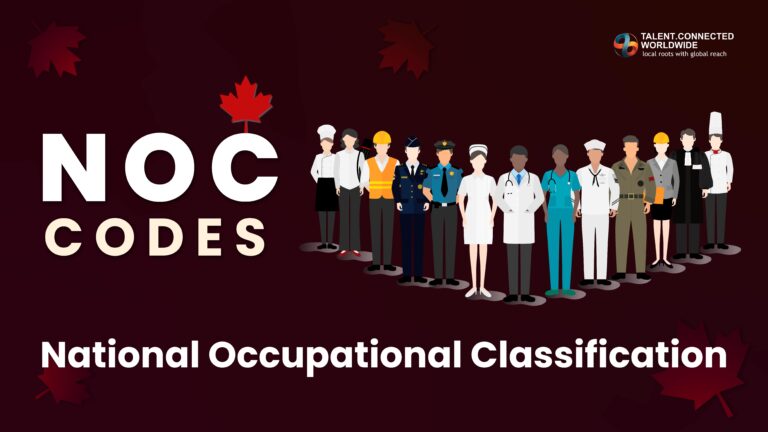
What are NOC codes?
NOC stands for National Occupational Classification. For most immigrants aiming to settle in Canada, NOC codes are simply job codes relevant to the country’s various immigration programs. However, NOC is not exclusively used in the immigration process. They provide a standardized and reliable source for understanding occupations and domains of jobs to labor market analysts, career counselors, job seekers as well and employers.
The National Occupational Classification or NOC was first implemented in 1992 as a replacement for the Canadian Classification and Dictionary of Occupations (CCDO). It was developed by Employment and Social Development Canada (ESDC) and Statistics Canada (StatCan)
The Structure of NOC Codes
To understand the information denoted by NOC codes, it is necessary to understand their structure.
Structure of NOC 2016 version 1.3
The structure of NOC codes in the 2016 version consists of five parts.
I. Broad Occupational Category (BOC)
II. Skill Level
III. Major-group
IV. Minor Group
V. Unit Group
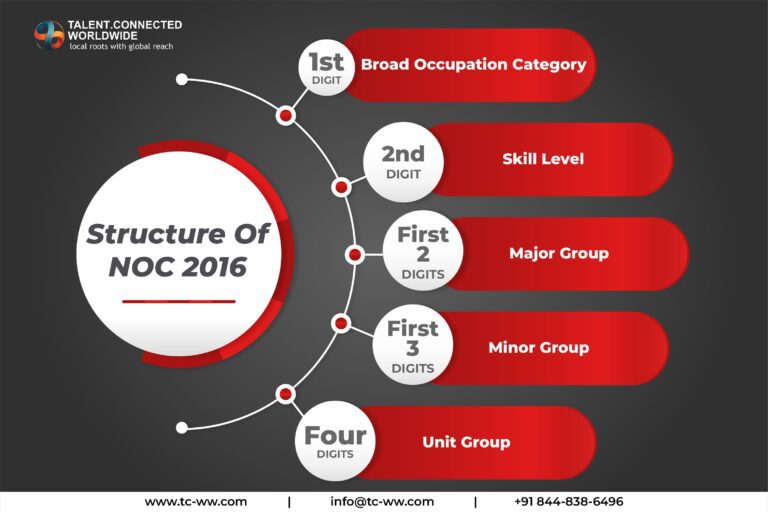
I. Broad Occupational Category
The Broad Occupational Category (BOC) indicates the nature of work and mandatory training and experience required to be employed in an occupation. It also reflects the qualifying academic requirements and segregates various fields of work into easily comprehensible domains. The very first digit of a NOC code signifies its broad occupational category. The 2016 NOC codes are divided into 10 BOCs.
BOC 0-Occupations in Management: these occupations include senior and middle management jobs along with legislative occupations. Job titles such as CEOs, MLAs, general managers, high commissioners, presidents, and vice presidents, usually belong to this broad occupation category. All NOC codes beginning with 0 belong to the senior management and legislative occupations.
For example, NOC code 0012 clearly depicts that all the job titles included in this code belong to the senior management occupation. 0012 is assigned to senior government managers and officials.

BOC 1-Occupations in the field of business, finance, and administration: Jobs such as accountants, investment analysts, dealers, financial officers, human resources, etc., belong to the broad occupational category 1. All job titles included in NOC codes beginning with digit 1 belong to the domains of business, finance, and administration.
For example, NOC 1111 belongs to financial auditors and accountants.
BOC 2-Occupations in Natural and Applied Sciences: All jobs belonging to the professional and technical fields of life science, physical science, architecture, engineering, and information technology belong to BOC 2. Job titles such as civil engineers, mechanical engineers, architects, mathematicians, etc. belong to this category.
All NOC codes starting with the digit 2 will belong to occupations in natural and applied sciences.
For instance, NOC 2111 begins with digit 2 and belongs to physicists and astronomers

BOC 3 Health occupations: All jobs belonging to professional and technical occupations in health and nursing are assigned the broad occupational category 3. Technical and professional designations such as physicians, dentists, pharmacists, etc. belong to this broad occupational category.
All NOC codes beginning with 3 will be related to health occupations.
For example, NOC 3011 is assigned to nursing coordinators and supervisors.
BOC 4-Occupations in the field of education, law and social, and community and government services: All designations in the domain of academia, law, social sciences, and public administration are included in the BOC 4. Designations such as university professors, college instructors, school teachers, judges, lawyers, policy researchers, etc. belong to this broad occupational category.
All NOC codes beginning with digit 4 will include jobs related to the field of education, law and social, and community and government services.
For example, NOC 4021 belongs to College and other vocational instructors.
BOC 5-Occupations in the field of art, culture, recreation, and sport: All technical and professional jobs related to films, videos, writing, journalism, museums, writings, recreation, and sports belong to broad occupational category 5. Job titles such as authors, journalists, athletes, announcers, etc. belong to the BOC 5.
NOC codes beginning with digit 5 will include jobs related to art, culture, recreation, and sports.
For instance, NOC 5211 belongs to library and public archive technicians.
BOC 6-Occupations in Sales and services
All occupations related to sales, customer services, tourism, and hospitality are included in broad occupation category 6. Job titles such as retail sales supervisors, real estate agents brokers, etc belong to BOC 6.
All NOC codes beginning with the digit 6 will include designations related to sales and services.
For example, NOC 6231 belongs to insurance agents and brokers.
BOC 7-Occupations related to trades, transport, and operators of equipment: Occupations under this category exist throughout various industries. Fields such as construction and mechanical trades, supervisors and contractors of trades, and operators of heavy equipment and transportation, belong to this broad occupational category. Most job titles included in this BOC require on-the-job training and licensing.
All the NOC codes that begin with digit 7 belong to this broad occupational category.
For Example, NOC 7203 belongs to contractors and supervisors, pipefitting trades.
BOC 8-Occupations in natural resources, agriculture, and related production: Industry-specific designations such as forestry, mining, fishing, gas production, etc are all included in the broad occupational category.
All the NOC codes that begin with the digit 8 belong to occupations related to natural resources and agriculture.
For instance, the NOC 8211 belongs to supervisors in logging and forestry.
BOC 9-Occupations in manufacturing and utilities: All the designations related to supervisory or production jobs in the field of utilities, processing, and manufacturing are included in the broad occupational category 9. All the NOC codes beginning with the digit 9 belong to occupations related to manufacturing and utilities.
For example, the NOC 9211 is allotted to supervisors in mineral and metal processing.
II. Skill Level
The skill level is the amount of training and academic proficiency mandatory to be eligible for employment in an occupation. The NOC 2016 version has four skill levels from Skill A to Skill D. The second digit in NOC codes denotes the skill level.
Skill A- NOC codes that belong to Skill level A are the ones that include job titles demanding a university degree such as a bachelor’s, master’s, doctoral, or postdoctoral.
Your Canada NOC code will fall under skill level A if the second digit of the code is 0 or 1. For example, the skill level of NOC code 1111 is A.
Skill B– NOC codes in skill level B are the ones that include designations demanding a minimum of 2-3 years tertiary education from a community college, technological institute, or CEGEP- publicly funded institutions exclusive to Quebec’s education system. They might also require 2-5 years’ apprenticeship or 3 to 4 years of secondary school along with on-the-job specialized training for at least 2 years.
If the second digit of the NOC code is 2 or 3, the skill level of the job titles allotted to that code will be B. For example, the skill level of NOC code 1211 is B.
Skill C– Job titles and designations that only require a secondary education with 2 years of on-the-job training, or specific work experience are assigned to skill level C NOC codes.
All NOC codes with the second digit as 4 or 5 belong to skill level C. For instance, the NOC 1411 will belong to skill level C.
Skill D– Skill level D NOC codes are the ones that only require work demonstration or on-the-job training. These occupations do not require any formal education.
All NOC codes belonging to skill D will have their second digit as 6 or 7. The NOC code 9611 will belong to skill D.
Skill levels of NOC codes are better explained through the table below.
| Skill Level | Second Digit in the NOC Code |
|---|---|
|
A- University education required | 0 or 1 |
| B- 2-3 years’ college education or minimum 2 years training | 2 or 3 |
| C- Secondary education with 2 years of specialized training. | 4 or 5 |
|
D- No formal education. Job specific training | 6 or 7 |
III. Major Groups
The first two digits of NOC codes denote their major group. The broad occupation categories are further narrowed down to major groups. The NOC codes in the 2016 1.3 version have 40 major groups.
BOC 0- Management Occupations
Management occupations are further split into major groups such as 00, 01, 02, 03, 04, 05, 06, 07, 08, and 09.
| Major Groups | Occupational domains |
|---|---|
|
00 |
Occupations related to senior management |
|
01-05 | Specialized middle management |
|
06 |
Middle management in retail, wholesale trade and customer services |
|
07-09 |
Middle management in the field of trades, transportation, production and utilities. |
To understand the major groups better, let us take the example of NOC code 0421. The first two digits of 0421 are 04 that belong to specialized middle management occupations. Thus, if we look at 0421, it is allotted to administrators in postsecondary education and vocational training.
BOC 1 Occupations related to business, finance, and administration
| Major Groups | Occupational domains |
|---|---|
|
11 |
Professional occupations related to finance and business |
|
12 |
Occupations related to administration and financial supervisors. |
|
13 |
Business administration related to finance and insurance |
|
14 |
Occupations related to office support |
|
15 | Occupations related to distribution, tracking, and scheduling coordination |
For example, the first two digits of the NOC code 1415 are 14. This implies that this code belongs to the occupations related to office support in the fields of business, finance, and administration.
BOC 2 Natural and applied science
| Major Groups | Occupational domains |
|---|---|
|
21 |
Professional occupations related to natural and applied science |
|
22 |
Technical occupations in natural and applied science. |
If we take the example of NOC code 2222, the first two digits are 22. This means that code 2222 contains job titles related to technical occupations in natural and applied sciences.
BOC 3 Health Occupations
| Major Groups | Occupational domains |
|---|---|
|
30 |
Nursing occupations |
|
31 |
Occupations in health |
|
32 |
Technical occupations in health |
|
34 |
Assisting occupations in support of health services |
The NOC 3211 has its first two digits as 32. This clearly denotes that all the designations included in 3211 is related to technical occupations in health such as laboratory technologists, etc.
BOC 4 Educational, legal and social, and community and government services occupations.
| Major Groups | Occupational domains |
|---|---|
|
40 |
Professional occupations in educational services |
|
41 | Professional occupations in law and social, community, and government services |
|
42 |
Paraprofessional occupations in community government, and law and social services. |
|
43 |
Front-line public protection services |
|
44 | Occupations related to care providers, academic, legal, and public protection support services |
All NOC codes beginning with the first two digits 43 include designations related to front-line public protection services. For example, the NOC code 4312 is assigned to firefighters.
BOC 5 Occupations related to arts, culture, sports, and recreation
| Major Groups | Occupational domains |
|---|---|
|
51 |
Professional occupations in art and culture |
|
52 | Technical occupations in art, culture, sport, and recreation |
NOC codes such as 5121 and 5123 have 51 as their major group. Thus, it is related to professional occupations in art and culture. Evidently, 5121 is assigned to authors and writers, and 5123 belongs to journalists.
BOC 6 Sales and services occupations
NOC code such as 6211 belongs to the major group 62. This implies that the job titles under this NOC code belong to retail sales supervisors and specialized sales occupations.
| Major Groups | Occupational domains |
|---|---|
|
62 | Retail sales supervisors and specialized sales |
|
63 | Specialized services and service supervisors |
|
64 |
Sales representatives and salespersons in wholesale and retail trade |
|
65 |
Customer and personal services, and service representatives |
|
66 |
Sales support |
|
67 |
Service support and other service occupations. |
BOC 7 Occupations related to trades, transport, and equipment operators
| Major Groups | Occupational domains |
|---|---|
|
72 | Trades in industries, electricity, and construction |
|
73 |
Maintenance and equipment operation |
|
74 |
Installers, repairers, material handlers, etc. |
|
75 |
Heavy equipment operation, transport, and related maintenance occupations |
|
76 | Occupations related to trade helpers and construction laborers |
For example, NOC codes 7203, and 7204 are assigned to contractors and supervisors, pipefitting trades, and contractors and supervisors, carpentry trades, respectively. Their major group denoted by the first two digits 72, clearly indicates that these occupations belong to trades in industries, electricity, and construction.
BOC 8 Occupations related to natural resources, agriculture, and agricultural production.
| Major Groups | Occupational domains |
|---|---|
|
82 |
Supervisors and technical occupations |
|
84 |
Workers in natural resources, agriculture, and agricultural production |
|
86 |
Labourers in harvesting, landscaping and natural resources |
For example, job titles included in NOC codes 8421 and 8422 belongs to supervisors and technical occupations.
BOC 9 Occupation related to Manufacturing and Utilities
| Major Groups | Occupational domains |
|---|---|
|
92 | Processing, manufacturing, and utilities supervisors and central control occupations |
|
94 |
Processing and manufacturing machine operators, and production workers |
|
95 |
Assemblers in manufacturing |
|
96 | Laborers in processing, manufacturing, and utilities |
For example, the NOC codes such as 9611 and 9612 belong to laborers in mineral and metal processing, and workers in metal fabrication respectively. These occupations are all related to laborers in processing, manufacturing and utilities.
IV. Minor Groups
The minor groups are denoted by the first three digits of a NOC code. The 2016 version of NOC contains 140 minor groups.
To understand the minor groups better, let us take the example of NOC 2112. The minor group in this case will be 211. Minor groups further narrow down and specify the major groups. Thus, in the case of NOC code 2112, the major group 21 which includes professional occupations related to natural and applied science is further segregated into 211 which is assigned to physical science professionals. This makes the information given by the NOC code extremely specific. Hence, the NOC 2112 is assigned to chemists.
V. Unit groups
NOC codes in the 2016 version contain 500 unit groups. Unit groups form the most specific and detailed unit of NOC. They are denoted by all four digits of the NOC code.
Anatomy of a 2016 NOC code
The figure will make the structure of Canada NOC codes clear.
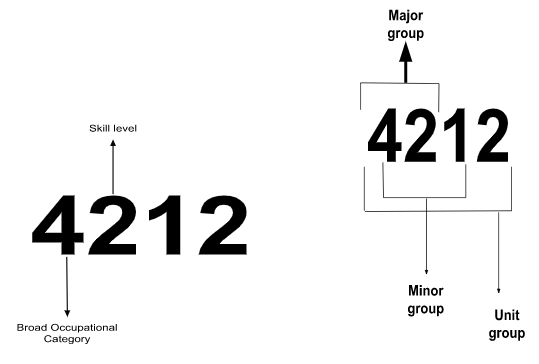
The following information can be determined by the NOC code in the images above
- Since the first digit is the broad occupational category, the job titles included in NOC 4212 belong to BOC 4 – Occupations in education, law, and social, community, and government services.
- The second digit signifies the skill level. The second digit here is 2 which means that the skill level is B.
- The first two digits of the NOC code further narrow down the occupations in education, law, and social, community, and government services. The major group 42 signifies paraprofessional occupations in the field.
- The minor group or the first three digits of the NOC code are 421. This further narrows down the paraprofessional occupations.
- The minor group 421 is further subdivided into 6 unit groups, and 4212 is one of the 6 unit groups. NOC 4212 is thus assigned to social and community service workers.
NOC code changes: NOC 2021 version 1.0
The NOC codes for Canada undergo major structural changes every ten years. These changes are conducted to ensure that the NOC reflects the latest Canadian economy and labor market conditions. The NOC 2016 version has undergone a major structural modification and has now become NOC 2021 version 1.0. The NOC codes 2021 have been developed by ESDC and StatCan. Following are the changes NOC 2021 has brought about.
1. 5 digit codification
The 4-digit NOC codes have now been replaced by a more specific 5-digit codification. For instance, the NOC 0011 assigned to legislators has now become 00110 in the NOC 2021 version. The NOC Codes 2021 now have broad occupational categories, major groups, sub-major groups, minor groups, and unit groups.
2. The TEER system
The skill levels of NOC codes are now going to be replaced by TEER in the NOC 2021 version. The second digit in the new 5-digit NOC denote the TEER level. TEER stands for Training, Education, Experience, and Responsibilities mandatory to be employed in an occupation.
| NOC 2016 1.3 Skill Level | NOC 2021 1.0 TEER |
|---|---|
|
Skill 0 |
TEER 0– Management and legislative occupations |
|
Skill A |
TEER 1– Compulsory university degree |
| Skill B | TEER 2– college education or 2 years’ training TEER 3– College diploma, or less than 2 years training, or more than 6 months on-the-job training |
|
Skill C |
TEER 4– high school education and on-the-job training |
|
Skill D |
TEER 5– No formal education required. Substantial amount of practical, job specific training. |
3. The NOC 2016 had most of the NOC codes under skill level B. This made it difficult to study and analyze all the occupations under skill B NOC codes. The NOC 2021 splits the skill level B into TEER 2 and TEER 3. This makes the new NOC 2021 easier to study and analyze.
How to find your NOC code?
Follow the steps below to find your NOC code.
STEP 1: Visit https://noc.esdc.gc.ca/
STEP 2: Select the NOC version 2021 if you aim to find your NOC code in the latest version. If you want to find your code in the 2016 NOC version, select NOC 2016 version 1.3. Please note that NOC 2021 was implemented everywhere after 16th November 2022. However, you can find your NOC code throughout all given NOC versions.
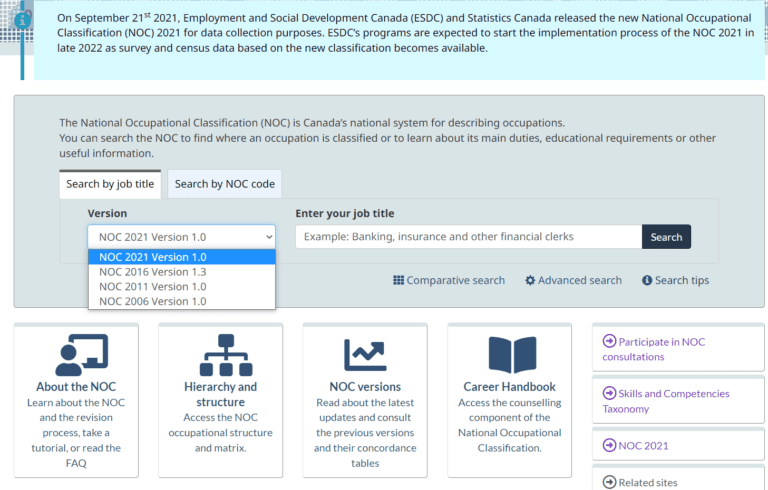
STEP 3: Select “Search by job title”.
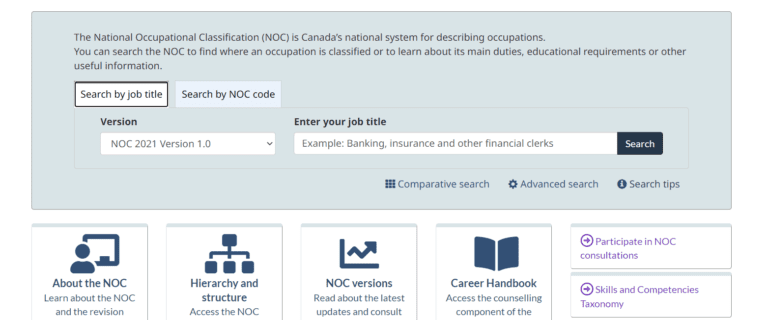
STEP 4: Type Your Designation
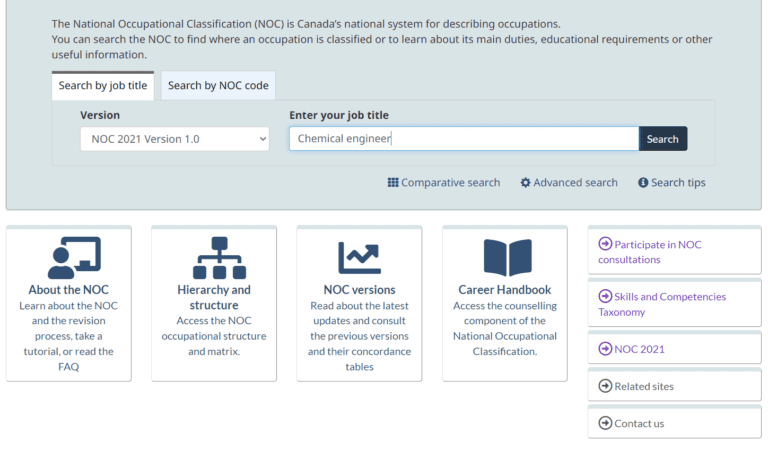
STEP 5: All the job results related to your search will appear. You can filter them as per your requirements.
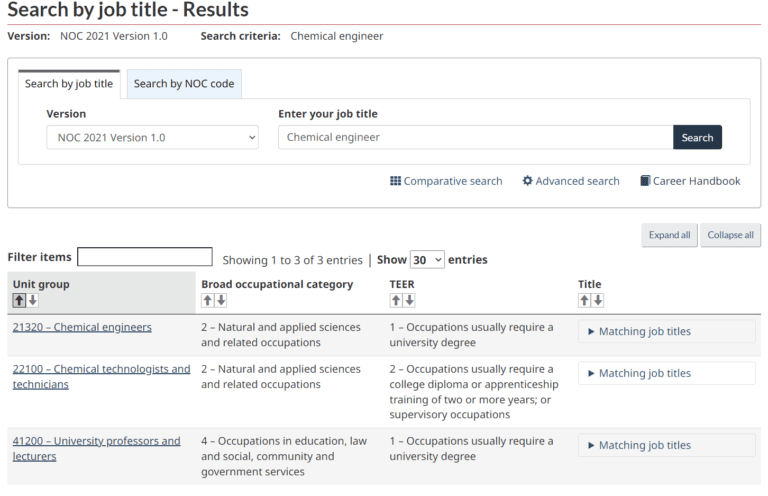
These are the steps to find your NOC code through your job title.
National Occupational Classification through the Years
| Year | Revision | Change |
| 1992 | NOC first published | Replaced Canadian Classification and Dictionary of Occupations |
| 2001 | NOC 1992 revised | Minor changes in Information Technology. NOC-S was published to replace Standard Occupation Classification (SOC). |
| 2006 | NOC minor update | A few more job titles were added. |
| 2011 | NOC major change and merger | NOC 2006 and NOC-S merged. Major revision cycle and structural change. |
| 2016 | NOC 2016 published | Structure of NOC 2016 remained unchanged, but many new occupations were added along with added specialties. NOC was now structured according to the Generic Statistical Information Model (GSIM). NOC 2016 underwent 5 major changes: |
| 2016–2019 | NOC 2016 changes | The NOC 2016 underwent 5 major changes: NOC 2016 – Oct 2016, NOC 2016 version 1.0 – May 2017, NOC 2016 version 1.1 – Dec 2017, NOC 2016 version 1.2 – Dec 2018, NOC 2016 version 1.3 – Dec 2019. |
| 2021 | NOC 2021 published | NOC 2021 underwent a major structural change and became TEER or Training Education, Experience, and Responsibilities. It was implemented for all immigration programs from Nov 16, 2022. The four-digit codification system is now replaced by a new five-digit code. |
Uses of NOC codes for Canada
Primarily, the National Occupational Classification (NOC) serves as a homogenous language to describe the jobs and occupational duties shouldered by Canadians. The NOC codes for Canada serve many important purposes.
- Data Collection.
The structure of NOC makes data collection of occupational information simple. This occupational information is then utilized by economists and statistical analysts. The NOC codes are also utilized by the government of Canada and its provinces for all analyses and surveys related to jobs and the labor market.
- Labour Market Analysis
Labour Market Analysis is the process that determines the supply and demand for labor. NOC codes are foundational, primary, and indispensable sources of information for all labor market analysis in Canada. NOC is utilized by labor market researchers to comprehend and interpret occupational statistics accurately. It provides a reliable and dependable context for the understanding of statistical information and contributes to policy decisions and the national, regional, and local labor market.
- Job searches and Career planning.
Each NOC code defines occupations, qualifying requirements for employment, job responsibilities and duties, educational requirements, etc. All Canadian employees, students, career counselors, career developers, and employers depend and rely upon this information denoted by the NOC code. Anyone aiming to work in Canada relies on the information provided by the National Occupational Classification.
- Job Bank
Canada Job Bank is a website that provides accurate and relevant information about the Canadian labor market. Additionally, it serves as a platform for both Canadian employers for posting available job vacancies, as well as, for aspiring job-seekers to search for the most suitable job. NOC or the National Occupational Classification is the source of all the information in Canada Job Bank.
- Immigration Programs
The Canada Immigration programs such as the Express Entry and the Provincial Nominee Program, also refer to the NOC to determine the work experience and eligibility of an aspiring immigrant.
The government of Canada adopts and utilizes the NOC codes to study and analyze data of occupations collected from the Labour Force Survey and Census. The governments of various Canadian provinces as well as most private companies also refer to and consult the National Occupational Classification NOC. Thus, NOC is the standardized language and source of information throughout Canada and is the foundation of all surveys related to labor mobility, labor market activities, technological changes, and administrative data.
The NOC codes for Canada have undergone various positive changes that are bound to impact various immigration programs. The most appropriate way to understand all the changes and stay updated is to consult a CICC/ICCRC-authorized immigration representative. The best immigration consultants not only make all the changes accessible and comprehensible, but they make sure to use them to your benefit. Talent Connected Worldwide is the only CICC-licensed immigration firm that aims to make your Canada immigration smooth, safe, and seamless.
Frequently Asked Questions
Finding your NOC code and skill level?
1. Visit the official NOC site https://noc.esdc.gc.ca/
2. Enter your job title or NOC code in the search bar.
3. Click on the search button.
4. Enter your occupation and see the code.
How is the NOC Organized?
Each digit of the NOC describes a trait about the NOC such as skill level, TEER level, Broad Occupation Classification, major and minor group to the accurate job title.
Why is the NOC system used?
It is the easiest and most organized form of job classification that eases the application for the applicants
How to select the correct NOC code?
The process is very simple:
1. Just visit the ESDC website.
2. Enter the job title for which you are searching the NOC code.
3. Now click on the search button
4. And you will get the correct NOC code three.
What NOC (National Occupational Classification) type will ‘Data Engineer’ be for Canada?
Data scientists earlier known as Data Engineer as per the old NOC 2016 version was NOC 2172. After the introduction of the new NOC 2021, it is denoted as NOC 21211.


